Reviews
Ralph Bakshi
USA, 1987–1988
Credits
Review by Matt Bailey
Posted on 27 April 2011
Source Paramount DVD
Categories Ralph Bakshi’s Cool Worlds
Towards the end of the 1980s, Ralph Bakshi had pitched cartoon after cartoon to the broadcast networks and had wound up rejected every time. He had one last meeting at CBS and, having had all of his ideas for original shows turned down, decided to pitch a new version of an old Terrytoons cartoon show on which he had worked as an animator in his youth, “Mighty Mouse Playhouse.” Despite the fact that Bakshi didn’t even own the rights to the character at the time, CBS bought the pitch and cartoons on TV haven’t been the same since.
As his supervising director, Bakshi hired a talented cartoonist named John Kricfalusi who had been slaving away on terrible cartoons for Filmation and Hanna-Barbera but who had proven his talents directing the animation for Bakshi’s music video for the Rolling Stones’ “Harlem Shuffle.” Bakshi and Kircfalusi poached a number of other cartoonists from other studios and then rounded out the staff with a handful of fresh graduates of Cal Arts and started work on “Mighty Mouse: The New Adventures.”
With the exception of “Pee-wee’s Playhouse,” that incredible sui generis blending of live-action, puppetry, and animation that had quickly gained fans from preschoolers to professors, Saturday mornings circa 1987 were a wasteland of animation. The best cartoon show on the air was “Bugs Bunny & Tweety,” a half-hour anthology of decades-old, bowdlerized Looney Tunes shorts. Nearly every other cartoon was based on a toy (“The Care Bears,” “Pound Puppies,” “My Pet Monster”), an existing live-action TV show (“Punky Brewster,” “Teen Wolf,” “ALF: The Animated Series”), or, astonishingly, a candy (“Disney’s Adventures of the Gummi Bears”). And then you had “Muppet Babies” and “The Smurfs” which dueled each other, inanely, on opposing networks for ninety goddamned minutes every week.
It may seem odd to say it about a cartoon, but what sets “Mighty Mouse: The New Adventures” apart from the rest of that Saturday morning line-up is its very “cartooniness.” In contrast with the rest of the cartoons whose production employed a creativity-crushing assembly line approach of script, followed by storyboard, layout, and then animation, with no director overseeing the overall style or tone of the cartoon, each “Mighty Mouse” cartoon was developed, written, and drawn by a small team of artists working closely together in the tradition of the Termite Terrace cartoonists who created Looney Tunes. The results - influenced by great Looney Tunes directors such as Bob Clampett, Frank Tashlin, and Chuck Jones as well as cartoon auteurs Tex Avery and Jay Ward - are extremely fast-paced and self-referential with a riot of sound effects, visual gags, extreme poses, and elastic bodies, a defiance of all laws of physics, and (as with any cartoon with which John Kricfalusi is involved) lots and lots of yelling.
Like all cartoons made for television until the advent of big budgets and computer assistance of the 1990s, though, the actual animation is pretty awful. While the art was all created by the artists in Bakshi’s studio, it was animated using the limited animation process by a studio in Taiwan (which was neither rare for the time nor rare now). What is different with “Mighty Mouse,” however, is that the artists anticipated the limitations of the animation and made it part of the visual style of the show. Instead of the movements of characters flowing from one realistic pose to another as they might in a Disney movie or standing in static poses, delivering dialogue with only their mouths moving as they might in a Hanna-Barbera or Filmation cartoon, the characters on “Mighty Mouse” jerk, smash, stretch, or hop from one exaggerated pose to another. Kricfalusi would later take this technique to new heights with “Ren and Stimpy.”
Each episode of “Mighty Mouse: The New Adventures” comprises two eleven-minute, unrelated cartoons. The show ran for two short seasons, the first containing thirteen episodes (twenty-six cartoons), the second only six (twelve cartoons), though some of the cartoons were made up almost entirely of clips from previous cartoons or even clips of old Terrytoons cartoons (which was purely a cost-saving measure, not an artistic choice). Yet in this short run of just over a year, the show matured from a grab bag of visual gags wildly inconsistent in tone and quality into a somewhat more consistent, demented and pointedly sharp satire. Some of the cartoons display the kind of brilliantly insane writing and drawing that hadn’t been seen on TV screens since the heyday of Jay Ward Productions. Yet in the same episode a great cartoon could be paired with another that, maddeningly, might be only just above the level of anything else in that abysmal Saturday morning schedule, making it clear that a director or team of artists just hadn’t yet grasped the tone of the show. But Bakshi’s young and mostly inexperienced staff readily admit that they were making it all up as they went along, doing the best they could against significant time and budget constraints and the very real limitations on what was possible on a broadcast network in Saturday morning animation for kids.
Because a strait-laced superhero mouse is just not a very appealing or interesting character, the cartoonists also plainly admit to pushing the main character of the show into the margins in favor of the villains or comedic side characters. (I expect this is pretty much why the best or most memorable things about all the Superman movies of the same era are the villains and, well, Richard Pryor). Though the continued truancy of the hero caused some friction with the network that bought a Mighty Mouse show and expected a Mighty Mouse show, it was in actuality the best thing for the show and for the viewers. The highest comedic points the show hit come from episodes such as “Night of the Bat-Bat,” “Mighty’s Benefit Plan,” and “Don’t Touch that Dial” in which the hero is almost entirely absent or serves merely as a linking device between gags.
The creators of the show not only placed no limits on their cast of characters, but they expanded the comedic targets of the show beyond Mouseville to include the history of animation and mass entertainment. In addition to not being very much about Mighty Mouse, each of three cartoons mentioned above was also a loving homage to and savage satire of classic and current television shows for kids. “Night of the Bat-Bat” recast the 1960s Batman series with a vigilante bat superhero who was, by day, actually a bat. “Mighty’s Benefit Plan” is a punch in the face to 1961’s “The Alvin Show,” to the “Alvin and the Chipmunks” cartoon then airing concurrently with “Mighty Mouse: The New Adventures” on NBC, and to its creators whose studio shared a building as Bakshi’s crew. “Don’t Touch That Dial” is a merciless caricature of Hanna-Barbera classics including “The Flintstones,” “The Jetsons,” and “Scooby-Doo, Where are You?” culminating in a mockery of the late-1980s cartoon “The Real Ghostbusters” that becomes “The Real Gagbusters,” four stock-still cartoon characters that speak in Bill Murray monotones and suck all the humor out of cartoons. The show also included references to, characters based upon, and voices inspired by figures as diverse as George C. Scott, Paul Lynde, Arnold Schwarzenegger, Kirk Douglas, Bob Hope, and Ralph Bakshi himself (once appearing as the witch in a Snow White take-off) as well as memorable parodies of “The Honeymooners” and “Perry Mason.”
The show was successful (artistically, if not commercially) and developed a following because, like the best of the cartoons that followed in its wake (specifically “Ren and Stimpy,” “Rocko’s Modern Life,” “Dexter’s Laboratory,” and “SpongeBob SquarePants”), it was pitched equally at little kids, smart-alecky teenagers, stoned college students, and nerdy adults who can appreciate a Joe Besser reference. It also helped that the show wasn’t try to sell anything to any member of that diverse audience. Along with “Pee-Wee’s Playhouse,” its immediate lead-in on CBS on Saturday mornings, “Mighty Mouse: The New Adventures” brought weird back to kids’ television and inaugurated a radical change in animation, almost single-handedly creating the genre of creator-driven, kid-tested, mother-approved cartoons that are now Nickelodeon’s and Cartoon Network’s stock in trade. In 1988, Nickelodeon was airing live-action kids’ shows such as “You Can’t Do That on Television” and “Double Dare” during the day and classic sitcoms at night. Cartoon Network was showing Looney Tunes marathons and a steady spate of vintage Hanna-Barbera cartoons. By the end of 1992, Nickelodeon was more famous as the home of Kricfalusi’s manic blockbuster “The Ren & Stimpy Show” as well as the more restrained “Rugrats” and “Doug,” and a couple of years later, Cartoon Network developed the “What a Cartoon” show that launched “Cow and Chicken,” “Dexter’s Laboratory,” “Johnny Bravo,” “Mike, Lu & Og,” “The Powerpuff Girls,” and “Courage the Cowardly Dog.”
But like all groundbreaking TV shows, “Mighty Mouse” suffered great indignities before its importance could be acknowledged. CBS pulled it from its time slot following “Pee-wee’s Playhouse” and stuck it at noon (the graveyard of Saturday mornings), giving the execrable “Garfield and Friends” the show’s old time slot. Then, halfway through the second season, the network pulled the plug on the show, yet reran the existing episodes into the ground for another several months. The next season, CBS gave the post-Pee-wee slot to (and I wish I were kidding about this) “The California Raisin Show,” a cartoon based on a commercial for dried fruit, and gave the noon slot to “The Adventures of Raggedy Ann and Andy,” a cartoon about a couple of seventy-year-old dolls. After that, I’m pretty sure kids and adults alike just stopped watching network TV on Saturday mornings because the only things on today are Disney Channel reruns and something called “The Doodlebops Rockin’ Road Show,” the existence of which I think no person of any age over three would voluntarily admit.
More Ralph Bakshi’s Cool Worlds
-
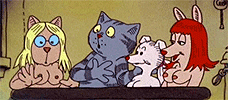
Fritz the Cat
1972 -
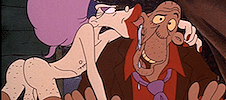
Heavy Traffic
1973 -
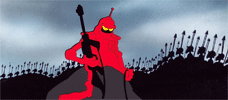
Wizards
1977 -
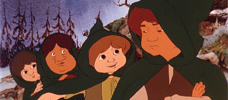
The Lord of the Rings
1978 -
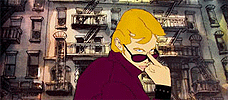
American Pop
1981 -
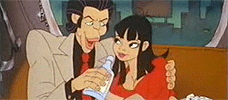
Hey Good Lookin’
1982 -
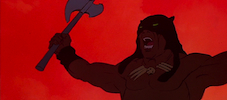
Fire and Ice
1983 -
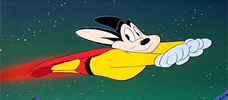
Mighty Mouse: The New Adventures
1987–1988 -
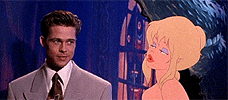
Cool World
1992 -
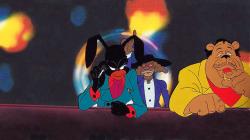
Coonskin
1975
We don’t do comments anymore, but you may contact us here or find us on Twitter or Facebook.



